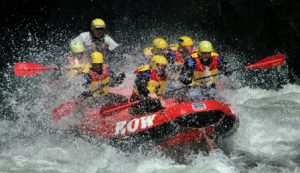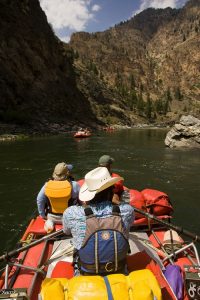If there is heaven on earth, it can be found on the Middle Fork of the Salmon River in central Idaho. This 104-mile-long whitewater trip through the heart of the Frank Church River of No Return Wilderness has everything that makes the perfect trip: great whitewater, deep wilderness, pristine camping spots, and daily natural hot springs.
What is often simply referred to as the Middle Fork begins at the confluence of Bear Valley Creek and Marsh Creek on the northern flank of the Sawtooth Range roughly 20 miles northwest of Stanley, Idaho. Ten miles below this confluence is the standard put-in boat launch at Boundary Creek, just below Dagger Falls. The river then traverses northeast through the most remote part of central Idaho. The take-out is just below the confluence with the Main Salmon, about 50 miles northwest of Salmon, Idaho. The put-in elevation is 5,800 feet above sea level, and the take-out is at 3,000 feet, giving the river an average gradient of 28 feet per mile.
Middle Fork trips can be privately organized, or guided by rafting companies. The U.S. Forest Service manages the activities on the river and allows groups of up to 24 people. The trips typically last between 6-days and 8-days. No roads reach the river between the put-in and the confluence with the Main Salmon. Wildlife is abundant in the rugged canyon, including deer, elk, bighorn sheep, mountain goat, and bear. The fishing is also outstanding, including salmon, steelhead, cutthroat, rainbow, whitefish, and Dolly Varden.
Most people enjoy the river on large rubber rafts. Experienced boaters often use whitewater kayaks and travel with rafters who carry both people and gear. McKenzies, dories, and drift boats can also be used.

The difficulty of the whitewater rapids on the Middle Fork depends greatly on the water level, which varies by snowpack and the time of the year. At high water the most difficult rapids are graded class IV+, which is defined as long, difficult rapids with constricted passages that often require precise maneuvering in very turbulent waters. The most challenging rapid is one of the first after the put-in, named Velvet Falls because you can’t hear it coming due to the Class II water immediately above it. At lower levels, the difficulty of the rapids on the river goes down to class III, which is considerably more moderate. That said, most of the rapids are fairly straight forward, and for kayakers, there is endless surfing and play boating opportunities.
Middle Fork campgrounds are designated, which means if you are organizing your own trip, you need to sit down with a ranger and hash out where you are going to camp each night in advance of the trip. Each party is allowed one hot springs campground during the duration of the trip.
The Middle Fork has an incredible history. Human artifacts have been found along the river dating back 8,000 years. Pictographs in caves and on rock walls can still be seen. In 1968 the Middle Fork was protected as a Wild River, becoming a charter member of the National Wild and Scenic Rivers System.
The magic of the Middle Fork really lies in the length of the trip, the fun whitewater, the deep wilderness component, and the number of natural hot springs. After about the third day of floating on this river, you tend to forget all your troubles, and feel as if your entire life has been a float down an endless river. Everyone should experience this unforgettable trip at least once during their lifetime. //

Guided Trips, Permit Process, and Amenities
Each year, over 10,000 people float the Middle Fork, about 40 percent in private parties, and the remainder with commercial outfitters. The Middle Fork is administered under a permit system to protect its fragile ecosystem from human use. A lottery system is used to manage trips for launches between May 28 and September 3. Lottery applications are accepted annually from December 1 until January 31. Reservations for pre and post-season float permits (before May 28 and after September 3) become available annually on October 1 (limit of 7 per day). The Middle Fork is typically not floated between November 1 and March 31 due to winter conditions, inaccessible roads, and low water.
There are a number of rules that must be followed during a trip, including minimum impact camping, use of a portable toilet, and a fire pan for all fires. Details are available at www.recreation.gov. Organizing a private trip is a significant undertaking, but very rewarding.
All but the most experienced whitewater boaters should do the trip with a commercial guide. There are a large number of commercial guides to choose from. Locally based ROW Adventures has been offering Middle Fork trips for decades (rowadventures.com/idaho-middle-fork-salmon-rafting). In addition, there are also a number of companies that rent rafting equipment to private groups specifically for such trips.
The beautiful town of Stanley offers the best lodging in advance of a trip on the Middle Fork. Sawtooth Hotel (sawtoothhotel.com) and Redfish Lake Lodge (redfishlake.com) are the best known in town. Check out Bertram’s Salmon Valley Brewery in the town of Salmon between the takeout and put-in for good food and brews (bertramsbrewery.com).













